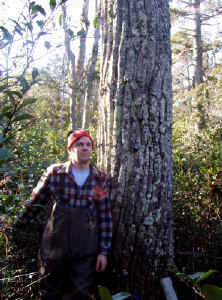Dear
ENTS,
I was hoping to report to ENTS the discovery of old-growth
Atlantic white-cedar on the Albemarle Peninsula in NC. Ben
Poulter of
Duke secured a grant to investigate the Buckridge Preserve near
Gum
Neck, NC. This preserve is mostly a pocosin forest bordering the
Alligator River and is 'only' ditched on two sides, which is
minimal
ditching for the region. Aerial photographs over the last 50
years show
no roads, rail beds or signs of human disturbance. The lack of
rail
beds is significant as they typically persist in the landscape
for a
long time [how long, I'm not exactly sure]. Further, few people
[if
any], including those working for the state of NC for 10-20 yrs
and
love field work, have explored this preserve. The entire region
is a
wild place. It is home to black bear, red wolves, eagles [saw 3
on
this trip], 'gators, canebreak rattlesnakes and flocks and
flocks of
birds [we saw wintering tundra swans on this visit].

Unfortunately, at least 2/3rds of the forest has been knocked
down by
Hurricane Isabel in September 2003. Field work was difficult
given the
amount of downed debris and smilax regrowth. We did explore a
good part
of the area and cored ~100 trees. The ages do not look old, but
no
final ages have been determined. We will finish our analysis
this month
and report to the Div. of Coastal Management of NC.
What I do want to report to ENTS, however, is how fascinating
this
forest is. It is considered an evergreen temperate forest. What
makes
it unique, though, is that two of the dominant trees are
evergreen
hardwoods: loblolly bay [Gordonia lasianthus -
http://www.cnr.vt.edu/dendro/dendrology/syllabus/factsheet.cfm?ID=343]
and what is probably sweetbay Magnolia [Magnolia virginiana
-
http://www.cnr.vt.edu/dendro/dendrology/syllabus/factsheet.cfm?ID=334].
We still are waiting on ID confirmation of the sweetbay as well
as an
understory, mid-sized evergreen hardwood.
It is an incredible forest, especially when you visit in the
winter. No
snakes, no chiggers, no mosquitoes! I'll send pictures along to
Ed when
I receive them from Ben. Evergreen hardwoods in December in
North
Carolina is really fascinating. What really fascinates me,
however, is
how little is known about these forests and the species that
compose
them [excepting Atlantic white-cedar and, to a lesser extent,
pond pine
[Pinus serotina]. Check out the silvics manual links from
the link
above about loblolly bay and you'll see what I mean - most of
the
references on Gordonia date to the 1920's through the 1940's. If
the
understory species is what I think it is, there is a similar
story on
the limited amount of knowledge for that species. How long do
these
species live? How do they regenerate?
Anyhow, I do have one big tree collection for you. It is only
DBH. We
hope to get more measurements later [we will have ages, of
course]. We
literally stumbled onto a large loblolly bay on the way out on
the last
day. It measured 63.8 cm. We knew it was big compared to the
others we
had seen. We didn't realize how big until we did a little
internet
search. The champion loblolly bay in FLA is 64 cm DBH. So, we
nearly
equaled this tree on 3 days of fieldwork. Imagine what might be
out
there.
Hope all are well,
Neil
|